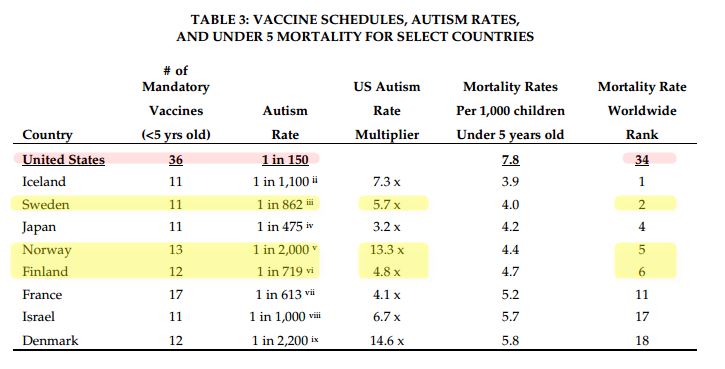Autism 2.75 X more likely in Hib vaccines containing Mercury
The risk of neurodevelopmental disorders following Thimerosal-containing Hib vaccine in comparison to Thimerosal-free Hib vaccine administered from 1995 to 1999 in the United States.
Int J Hyg Environ Health. 2018 May;221(4):677-683. doi: 10.1016/j.ijheh.2018.03.004. Epub 2018 Mar 14.
Geier DA1, Kern JK2, Homme KG3, Geier MR4.
1 The Institute of Chronic Illnesses, Inc, Silver Spring, MD, USA; CoMeD, Inc, Silver Spring, MD, USA.
2 The Institute of Chronic Illnesses, Inc, Silver Spring, MD, USA; CoMeD, Inc, Silver Spring, MD, USA; CONEM US Autism Research Group, Allen, TX, USA. jkern@dfwair.net.
3 International Academy of Oral Medicine and Toxicology, Champions Gate, FL, USA.
4 The Institute of Chronic Illnesses, Inc, Silver Spring, MD, USA.
 * Vaccinated children had more chronic diseases - Sept 2018 has the following table
650 homeschooled children
| | | |
| --- | --- | --- |
| Chronic Illness Diagnosis | % Vaccinated | % Unvaccinated |
| Children Diagnosed Allergic Rhinitis | 10.4% | 0.4% |
| Other allergies | 22.2% | 6.9% |
| Eczema/atopic dermatitis | 9.5% | 3.6% |
| Learning disability | 5.7% | 1.2% |
| ADHD | 4.7% | 1.0% |
| Any neurodevelopmental disorder | 10.5% | 3.1% |
| Any chronic illness | 44.0% | 25.0% |
---
1. See also about the authors on the web
* Authors have published many studies on Vaccines and Autism
* http://markgeiervaccines.com/
* Vaccinated children had more chronic diseases - Sept 2018 has the following table
650 homeschooled children
| | | |
| --- | --- | --- |
| Chronic Illness Diagnosis | % Vaccinated | % Unvaccinated |
| Children Diagnosed Allergic Rhinitis | 10.4% | 0.4% |
| Other allergies | 22.2% | 6.9% |
| Eczema/atopic dermatitis | 9.5% | 3.6% |
| Learning disability | 5.7% | 1.2% |
| ADHD | 4.7% | 1.0% |
| Any neurodevelopmental disorder | 10.5% | 3.1% |
| Any chronic illness | 44.0% | 25.0% |
---
1. See also about the authors on the web
* Authors have published many studies on Vaccines and Autism
* http://markgeiervaccines.com/
PDF is available free at Sci-Hub 10.1016/j.ijheh.2018.03.004
Investigators postulated that early-life exposure to organic mercury (Hg) significantly increases the risk of childhood neurodevelopmental disorders (NDs). The Vaccine Adverse Event Reporting System database was utilized to conduct a hypothesis testing case-control study by evaluating 3486 total adverse event reports reported following Haemophilus influenza type b (Hib) vaccination. Exposed subjects received a Thimerosal-containing formulation (HIBTITER™, Wyeth-Lederle), while unexposed subjects received a Thimerosal-free formulation (PEDVAXHIB™, Merck). Subjects were included if they received either of these two Hib vaccine formulations between 1995 and 1999. Cases were defined as adverse event reports with a reported outcome of autism, developmental delay, psychomotor delay, or NDs in general. Cases with reported outcomes of febrile convulsions, pyrexia, or injection site pain, all of which have no biologically plausible relation to Hg exposure, were also examined. Controls were defined as adverse event reports without any mention of the specific case outcome examined.
Cases of reported
autism (odds ratio (OR) = 2.75 , p < 0.02),
developmental delay (OR = 5.39, p < 0.01),
psychomotor disorder (OR = 2.38, p < 0.03), and
neurodevelopmental disorder in general (OR = 2.70, p < 0.001)
were each significantly more likely than their respective controls to receive Thimerosal-containing Hib vaccine than Thimerosal-free Hib vaccine.
Significant effects for neurodevelopmental disorder in general were observed for males (OR = 2.52, p < 0.005), but not females when separated by gender. For the outcomes that had no biologically plausible relation to Hg exposure, the cases were no more likely than their respective controls to receive Thimerosal-containing Hib vaccine than Thimerosal-free Hib vaccine. This study provides suggestive evidence of an association between Thimerosal and neurodevelopmental outcomes and provides support for carrying out additional well-designed studies examining the association between Thimerosal-containing vaccines and a wide range of neurodevelopmental outcomes.
